
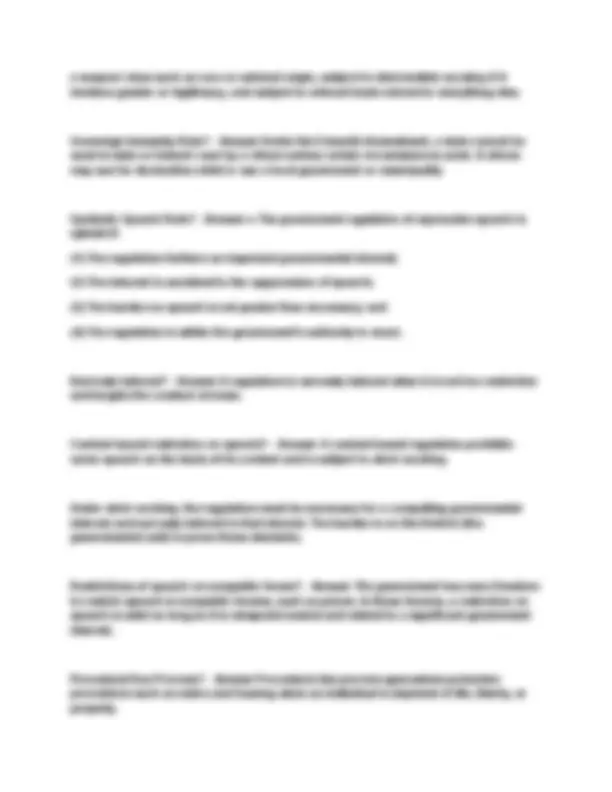
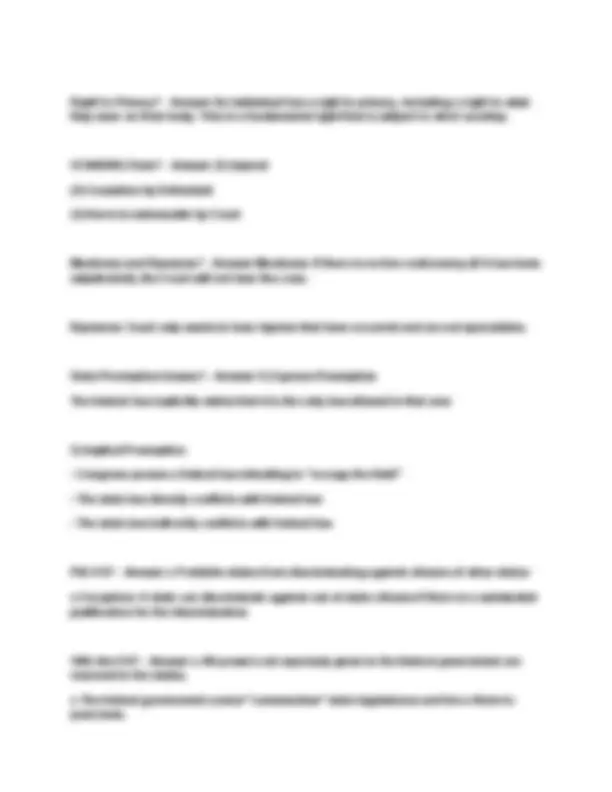
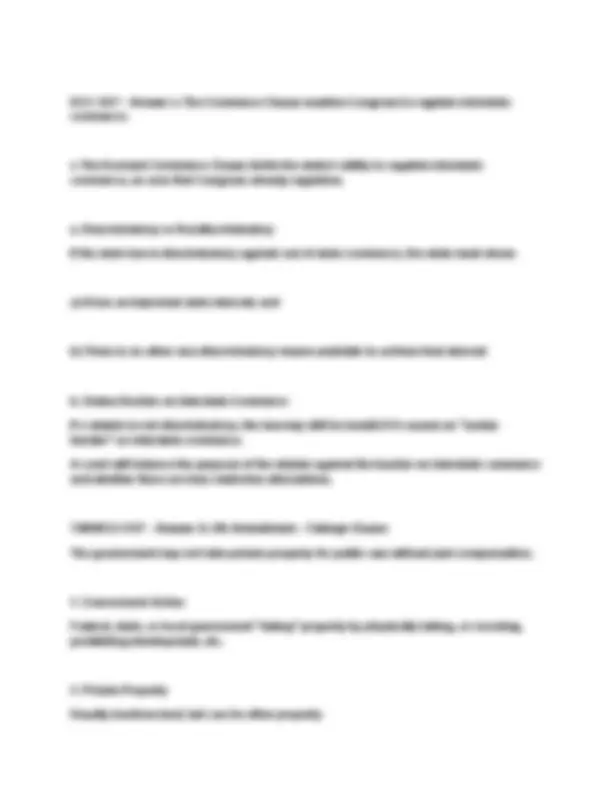
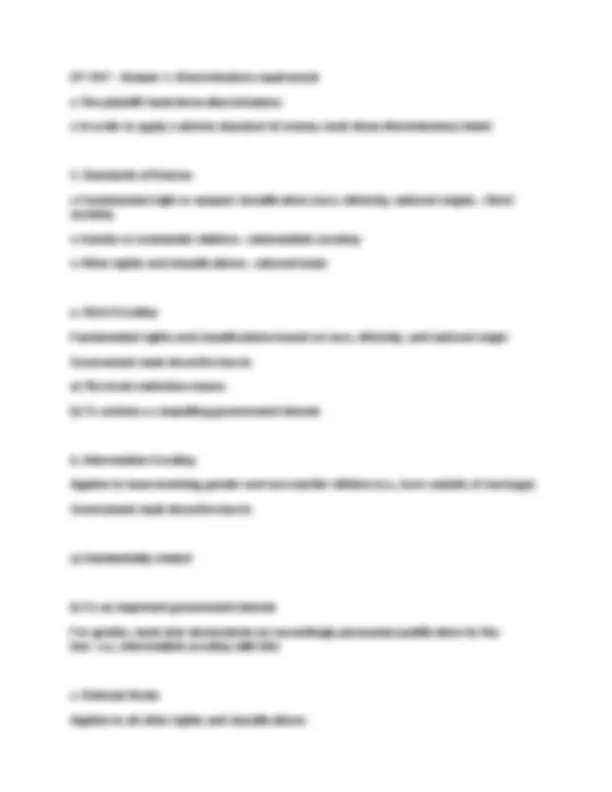
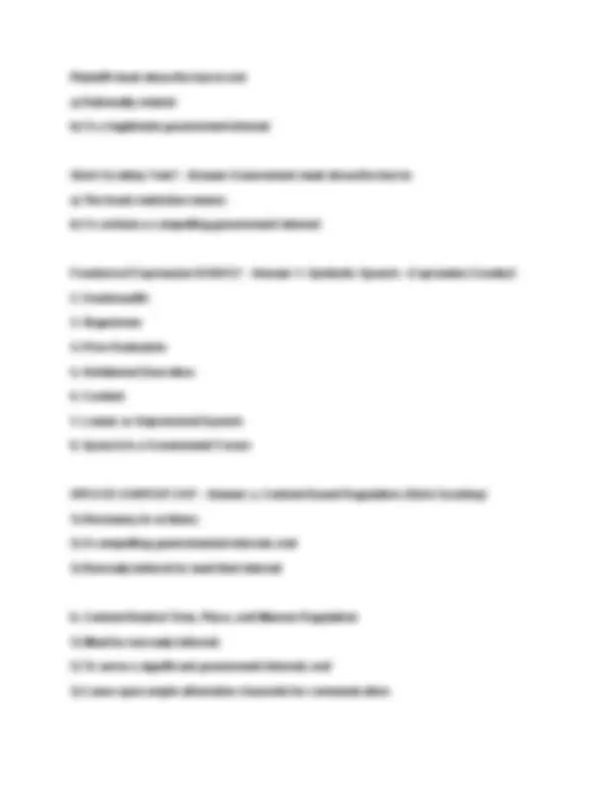
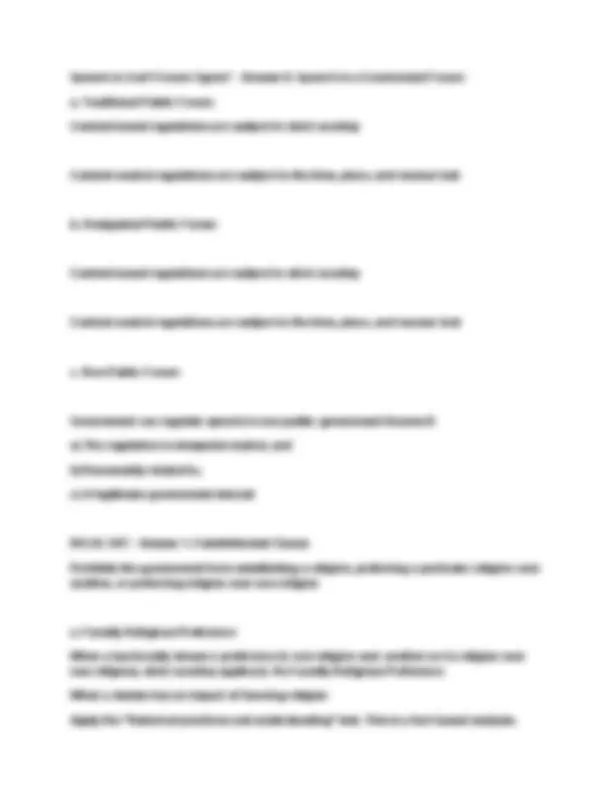


Study with the several resources on Docsity

Earn points by helping other students or get them with a premium plan


Prepare for your exams
Study with the several resources on Docsity

Earn points to download
Earn points by helping other students or get them with a premium plan
Community
Ask the community for help and clear up your study doubts
Discover the best universities in your country according to Docsity users
Free resources
Download our free guides on studying techniques, anxiety management strategies, and thesis advice from Docsity tutors
A comprehensive overview of key concepts in constitutional law, including standing, freedom of speech, procedural due process, substantive due process, equal protection, sovereign immunity, symbolic speech, takings, and more. It presents a series of questions and answers that are relevant to common exam topics, helping students prepare for their constitutional law exams. Particularly useful for students seeking to understand the application of these legal principles in real-world scenarios.
Typology: Exams
1 / 11

This page cannot be seen from the preview
Don't miss anything!







Con Law Topshelf? - Answer Standing To bring a constitutional action in federal court, the plaintiff must have standing underArticle III (because Article III only grants jx to "cases or controversies"). To show standing, the plaintiff must show: 1) injury in fact; 2) causation; and 3)redressability.
[RIPENESS ANALYSIS] [MOOTNESS ANALYSIS] Freedom of Speech Topshelf? - Answer As a preliminary matter, speech is broadlydefined under the 1st Amendment, and it can include symbolic/expressive conduct that would not be traditionally thought of as speech. State ActionTo show a First Amendment violation, P must first show that there was state action (the Constitution does not apply to private actors, other than the 13th Amendment, which isnot at issue here). State action simply means government action (it need not be at the"state" level; it can be local, federal, etc.). Vagueness Laws/policies infringing on the freedom of speech cannot be vague; this requires that thelaw give fair notice of the prohibited conduct such that a reasonable person would understand what is prohibited by the policy. OverbreadthSimilarly, a speech regulation will be struck down if it is overbroad, i.e., it regulates more speech than is necessary.
Symbolic Speech P will argue that D's policy impermissibly regulates expressive speech under the 1st and14th Amendments. The test is as follows: a regulation will be upheld only if:
14th Am OV? - Answer PROCEDURAL DUE PROCESS Under the 14th Amendment procedural Due Process Clause, no person shall be deprivedof life, liberty, or property without due process of the law. This requires a showing that 1) there was a deprivation of a protected interest, 2) without due process protections(namely, notice and a hearing). When deciding what process is due, the court looks at the nature of the interest affected, the probable value of additional safeguards, and theburden on the government.
SUBSTANTIVE DUE PROCESSUnder the 14th Amendment substantive Due Process Clause, the government shall not infringe on individual rights in an arbitrary or irrational manner. If the right isfundamental, strict scrutiny applies; if the right is not fundamental, it is subject to rational basis review. EP CLAUSEUnder the Equal Protection Clause, all individuals must be treated equally without discrimination. A restriction is subject to strict scrutiny if it discriminates on the basis of
Right to Privacy? - Answer An individual has a right to privacy, including a right to whatthey wear on their body. This is a fundamental right that is subject to strict scrutiny.
STANDING Rule? - Answer (1) Injured (2) Causation by Defendant(3) Harm is redressable by Court
Mootness and Ripeness? - Answer Mootness: If there is no live controversy (if it has beenadjudicated), the Court will not hear the case.
Ripeness: Court only wants to hear injuries that have occurred and are not speculative. State Preemption Issues? - Answer 1) Express Preemption The federal law explicitly states that it is the only law allowed in that area
- The state law directly conflicts with federal law • The state law indirectly conflicts with federal law
P&I OV? - Answer o Prohibits states from discriminating against citizens of other states o Exception: A state can discriminate against out-of-state citizens if there is a substantialjustification for the discrimination
10th Am OV? - Answer o All powers not expressly given to the federal government arereserved to the states. o The federal government cannot "commandeer" state legislatures and force them topass laws.
DCC OV? - Answer o The Commerce Clause enables Congress to regulate interstatecommerce.
o The Dormant Commerce Clause limits the states' ability to regulate interstatecommerce, an area that Congress already regulates.
a. Discriminatory or NondiscriminatoryIf the state law is discriminatory against out-of-state commerce, the state must show:
a) It has an important state interest; and b) There is no other non-discriminatory means available to achieve that interest b. Undue Burden on Interstate CommerceIf a statute is not discriminatory, the law may still be invalid if it causes an "undue burden" on interstate commerce.A court will balance the purpose of the statute against the burden on interstate commerce and whether there are less restrictive alternatives. TAKINGS OV? - Answer A. 5th Amendment — Takings Clause The government may not take private property for public use without just compensation.
(1) Procedural DP (2) Substantive DP
Fundamental rights (life, liberty, and property) • Strict scrutiny— only valid if necessary to achieve a compelling governmentalinterest
Non-fundamental rights
- Rational basis— valid if rationally related to a legitimate government interest
EP OV? - Answer 1. Discrimination requiremento The plaintiff must show discrimination o In order to apply a stricter standard of review, must show discriminatory intent
a. Strict Scrutiny Fundamental rights and classifications based on race, ethnicity, and national origin Government must show the law is:a) The least restrictive means b) To achieve a compelling government interest b. Intermediate ScrutinyApplies to laws involving gender and non-marital children (i.e., born outside of marriage) Government must show the law is: a) Substantially related b) To an important government interest For gender, must also demonstrate an exceedingly persuasive justification for thelaw — i.e., intermediate scrutiny with bite
c. Rational Basis Applies to all other rights and classifications
Speech in Gov't Forum Types? - Answer 8. Speech in a Government Foruma. Traditional Public Forum Content-based regulations are subject to strict scrutiny Content-neutral regulations are subject to the time, place, and manner test b. Designated Public Forum Content-based regulations are subject to strict scrutiny Content-neutral regulations are subject to the time, place, and manner test c. Non-Public Forum Government can regulate speech in non-public government forums if:a) The regulation is viewpoint-neutral, and b) Reasonably related to,c) A legitimate government interest
RELIG OV? - Answer 1. Establishment Clause Prohibits the government from establishing a religion, preferring a particular religion overanother, or preferring religion over non-religion
a. Facially Religious PreferenceWhen a law facially shows a preference to one religion over another (or to religion over non-religion), strict scrutiny applies.b. No Facially Religious PreferenceWhen a statute has an impact of favoring religion Apply the "historical practices and understanding" test. This is a fact-based analysis.